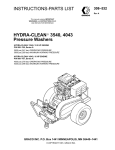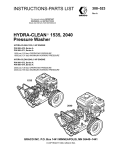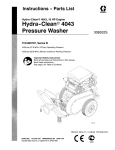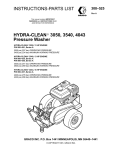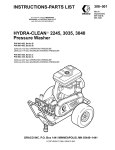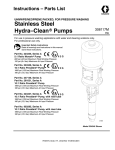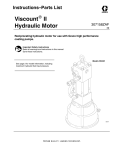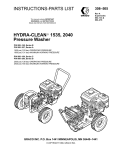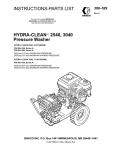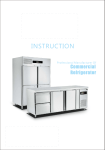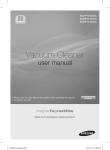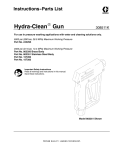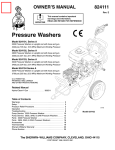Download Graco Inc. 308-530 Pressure Washer User Manual
Transcript
INSTRUCTIONS-PARTS LIST 308–530 Rev A This manual contains IMPORTANT WARNINGS and INSTRUCTIONS READ AND RETAIN FOR REFERENCE HYDRA-CLEAN 1535, 2040, 2540 Pressure Washers HYDRA-CLEAN 1535, 5 HP ENGINE P/N 800–698, Series A 1500 psi (103 bar) OPERATING PRESSURE 1900 psi (131 bar) MAXIMUM WORKING PRESSURE HYDRA-CLEAN 2040, 8 HP ENGINE P/N 800–699, Series A 2000 psi (138 bar) OPERATING PRESSURE 2400 psi (165 bar) MAXIMUM WORKING PRESSURE HYDRA-CLEAN 2540, 9 HP ENGINE P/N 800–700, Series A 2500 psi (172 bar) OPERATING PRESSURE 3000 psi (207 bar) MAXIMUM WORKING PRESSURE 1535 2040 2540 GRACO INC. P.O. Box 1441 MINNEAPOLIS, MN 55440–1441 COPYRIGHT 1991, GRACO INC. INDEX Warnings . . . . . . . . . . . . . . . . . . . . . . . . . . . . . . . . . . . . . . . . . . . . . . . . . . . . . . . 3 Installation . . . . . . . . . . . . . . . . . . . . . . . . . . . . . . . . . . . . . . . . . . . . . . . . . . . . . 5 Startup . . . . . . . . . . . . . . . . . . . . . . . . . . . . . . . . . . . . . . . . . . . . . . . . . . . . . . . . . 6 Shutdown, Flushing and Storage . . . . . . . . . . . . . . . . . . . . . . . . . . . . . . . . . . 8 Maintenance . . . . . . . . . . . . . . . . . . . . . . . . . . . . . . . . . . . . . . . . . . . . . . . . . . . . 8 Troubleshooting Chart . . . . . . . . . . . . . . . . . . . . . . . . . . . . . . . . . . . . . . . . . . . 9 Hydra–Clean 1535 . . . . . . . . . . . . . . . . . . . . . . . . . . . . . . . . . . . . . . . . . . . . 10 Hydra–Clean 2040 . . . . . . . . . . . . . . . . . . . . . . . . . . . . . . . . . . . . . . . . . . . . 12 Hydra–Clean 2540 . . . . . . . . . . . . . . . . . . . . . . . . . . . . . . . . . . . . . . . . . . . . 14 Gear Reducer (Model 1535) . . . . . . . . . . . . . . . . . . . . . . . . . . . . . . . . . . . . 16 Gear Reducer (Models 2040 & 2540) . . . . . . . . . . . . . . . . . . . . . . . . . . . . 18 Pump (Model 1535) . . . . . . . . . . . . . . . . . . . . . . . . . . . . . . . . . . . . . . . . . . . 20 Pump (Model 2040) . . . . . . . . . . . . . . . . . . . . . . . . . . . . . . . . . . . . . . . . . . . 22 Pump (Model 2540) . . . . . . . . . . . . . . . . . . . . . . . . . . . . . . . . . . . . . . . . . . . 24 Pump Service (Model 1535) . . . . . . . . . . . . . . . . . . . . . . . . . . . . . . . . . . . . 26 Pump Service (Models 2040 & 2540) . . . . . . . . . . . . . . . . . . . . . . . . . . . . 28 Accessories . . . . . . . . . . . . . . . . . . . . . . . . . . . . . . . . . . . . . . . . . . . . . . . . . . 30 Technical Data . . . . . . . . . . . . . . . . . . . . . . . . . . . . . . . . . . . . . . . . . . . . . . . . 31 Warranty . . . . . . . . . . . . . . . . . . . . . . . . . . . . . . . . . . . . . . . . . . . . . Back Cover TERMS WARNING: Alerts user to avoid or correct conditions that could cause bodily injury. CAUTION: Alerts user to avoid or correct conditions that could cause damage to the equipment. 308–530 NOTE: Identifies helpful procedures and information. WARNING HIGH PRESSURE SPRAY CAN CAUSE SERIOUS INJURY. FOR PROFESSIONAL USE ONLY. OBSERVE ALL WARNINGS. Read and understand all instruction manuals before operating equipment. FLUID INJECTION HAZARD General Safety This pressure washer generates very high fluid pressure. Spray from the gun, leaks or ruptured components can inject fluid through your skin and into your body and cause extremely serious bodily injury including the need for amputation. Also, fluid injected or splashed into the eyes or on the skin can cause serious damage. NEVER point the spray gun or wand at anyone or at any part of the body . NEVER put hand or fingers over the spray tip. ALWAYS follow the Pressure Relief Procedure, before cleaning or servicing any part of the sprayer. NEVER try to stop or deflect leaks with your hand or body. Be sure equipment safety devices are operating properly before each use. Medical Treatment If any fluid appears to penetrate your skin, get EMERGENCY MEDICAL TREATMENT AT ONCE. DO NOT TREAT AS A SIMPLE CUT. Tell the doctor exactly what fluid was injected. NOTE T O PHYSICIAN: Injection in the skin is a traumatic injury. It is important to treat the injury surgically as soon as possible. Do not delay treatment to research toxicity. Toxicity is a concern with some exotic coatings injected directly into the bloodstream. Consultation with a plastic surgeon or reconstructive hand surgeon may be advisable. Pressure Relief Procedure To reduce the risk of serious bodily injury, including fluid injection and splashing in the eyes or on the skin, always follow this procedure whenever you stop spraying for more than 10 minutes, when shutting down, and before checking or repairing any part of the system. 1. Engage the trigger safety latch. 2. Turn the sprayer off. 3. Remove the ignition cable from the spark plug. 4. Shut off the water supply. 5. Disengage the trigger safety latch and trigger the gun to relieve pressure, and then engage the trigger safety latch again. 6. Before long–term (overnight) storage or transporting of the unit, disconnect the water supply and turn off the fuel supply valve. Spray Gun Safety Devices Be sure all gun safety devices are operating properly before each use. Do not remove or modify any part of the gun; this can cause a malfunction and result in serious bodily injury. SAFETY LATCH: Whenever you stop spraying for a moment, always set the gun safety latch in the engaged or “safe” position, making the gun inoperative. Failure to properly set the safety latch can result in accidental triggering of the gun. SPRAY TIP SAFETY : Use extreme caution when cleaning or changing spray tips. If a spray tip clogs while spraying, engage the gun safety latch immediately . ALWAYS follow the Pressure Relief Procedure and then remove the spray tip to clean it. MOVING PARTS HAZARD Moving parts can pinch or amputate fingers or other body parts. KEEP CLEAR of moving parts when starting or operating the pressure washer. NEVER operate the pressure washer without all guards and interlocks installed and functioning. Follow the Pressure Relief Procedure before checking or servicing the pressure washer to prevent discharging high pressure fluid from the gun. Warnings continued on page 4. 308–530 3 EQUIPMENT MISUSE HAZARD General Safety Any misuse of the pressure washer or accessories, such as overpressurizing, modifying parts, using incompatible chemicals and fluids, or using worn or damaged parts, can cause them to rupture and result in fluid injection, splashing in the eyes or on the skin, or other serious bodily injury, fire, explosion or property damage. System Pressure This sprayer can develop high operating pressures. Be sure that all spray equipment and accessories are rated to withstand the maximum working pressure of this working sprayer. DO NOT exceed the maximum pressure of any component or accessory used in the system. NEVER alter or modify any part of this equipment; doing so could cause it to malfunction. CHECK all spray equipment regularly and repair or replace worn or damaged parts immediately. ALWAYS wear protective eyewear and appropriate clothing. If using a chemical injector, read and follow the chemical manufacturer’s literature for recommendations on additional protective equipment, such as a respirator. Chemical Compatibility BE SURE that all chemicals used in the chemical injector are compatible with the wetted parts of the hose, gun, wand and tip, as given in the Technical Data (inside back cover). Always read the chemical manufacturer ’s literature before using any chemical in this pressure washer. HOSE SAFETY High pressure fluid in the hoses can be very dangerous. If the hose develops a leak, split or rupture due to any kind of wear , damage or misuse, the high pressure spray emitted from it can cause a fluid injection injury or other serious bodily injury or property damage. ALL FLUID HOSES MUST HA VE STRAIN RELIEFS ON BOTH ENDS. The strain reliefs help protect the hose from kinks or bends at or close to the coupling, which can result in hose rupture. TIGHTEN all fluid connections securely before each use. High pressure fluid can dislodge a loose coupling or allow high pressure spray to be emitted from the coupling. NEVER use a damaged hose. Before each use, check entire hose for cuts, leaks, abrasion, bulging cover , or damage or movement of the hose couplings. If any of these conditions exist, replace the hose immediately. DO NOT try to recouple high pressure hose or mend it with tape or any other device. A repaired hose cannot contain the high pressure fluid. HANDLE AND ROUTE HOSES CAREFULL Y. Do not pull on hoses to move the pressure washer. Do not use chemicals which are not compatible with the inner tube and cover of the hose. DO NOT expose Graco hose to temperatures above 200_ F (93_ C) or below –40_ F (–40_ C). FUEL AND EMISSION HAZARDS NEVER fill the fuel tank while the unit is running or hot. The fuel used in this unit is combustible and when spilled on a hot surface can ignite and cause a fire. ALWAYS fill tank slowly to avoid spilling. NEVER operate the unit in a closed building. The exhaust contains carbon monoxide, a poisonous, odorless, invisible gas which can cause serious injury or death if inhaled. NEVER alter the throttle setting, which is factory set. Tampering with this adjustment can damage the pressure washer and will void the warranty. IMPORTANT United States Government safety standards have been adopted under the Occupational Safety and Health Act. These standards—particularly the General Standards, Part 1910, and the Construction Standards, Part 1926—should be consulted. 4 308–530 INSTALLATION 1535 2540 HIGH PRESSURE HOSE CONNECTION HIGH PRESSURE HOSE CONNECTION INLET WATER CONNECTION 3/4” GARDEN HOSE INLET WATER CONNECTION 3/4” GARDEN HOSE QUICK COUPLER 2040 SPRAY GUN QUICK COUPLER SPRAY HOSE HIGH PRESSURE HOSE CONNECTION INLET WATER CONNECTION 3/4” GARDEN HOSE Figure 1 Check for Shipping Damage Check the unit for any damage that may have occurred in shipping. Notify the carrier immediately if there is any damage. Set Up If you are using a downstream chemical injector, install it between the pump unloader and the high pressure hose, using the quick couplers provided. Connect the high pressure hose between the pump outlet and the gun inlet. Both of these connections are made with quick couplers. CAUTION Up to 100 ft (30 m) of high pressure hose may be used. Longer hoses may af fect sprayer performance, and chemical injector performance, if used. Install the appropriate spray tip on the wand. See Installing and Changing Spray T ips. If you are using a sandblaster kit, see its separate manual for installation instructions. Connect to Water Supply CAUTION Before attaching to the water supply, check your local plumbing code regarding cross–connection to the water supply . A backflow preventer , P/N 801–133, is available to prevent backflow of contaminated water into the fresh water supply . Install it upstream from the pump. If inlet water pressure is over 60 psi (4.1 bar) a regulating water valve, P/N 800–258, must be installed at the garden hose connection. Do not exceed 160 _ F (70 _ C) inlet water temperature. Connect a hose with at least a 3/4 inch (19 mm) ID from the water supply to the unit’s 3/4 inch garden hose inlet. The supply hose should not be more than 50 ft (15 m) long. NOTE: must have a The water source at the unit minimum flow rate equal to that of the unit (see Technical Data, inside back cover). 308–530 5 STARTUP Always use this startup procedure to ensure that the unit is started safely and properly. 1. Check oil levels. Engine: Add SAE 30 or 10W–30 weight detergent oil as necessary. Pump: Add SAE 20 or 30 weight non–detergent oil or genuine Cat pump oil as necessary. Gear Reducer (2040 and 2540): Add SAE 90 gear oil as necessary . The 1535 uses the oil in pump crankcase. NOTE: All units are equipped with a low–oil sensor that shuts the engine off if the oil level falls below a certain level. If the unit stops unexpectedly , check both the oil and the fuel levels. Check the oil level each time the unit is refueled. 2. Check fuel level. WARNING DO NOT refuel a hot engine. Refueling a hot engine could cause a fire. Use only fresh, clean regular or unleaded gasoline. Close the fuel shutoff valve during refueling. 3. Turn on the water supply. CAUTION Never run the unit dry. Costly damage to the pump will result. Always be sure the water supply is completely turned on before operating. If the engine is cold, completely close the engine choke. Grasp the starter rope, brace one foot on the pressure washer chassis and pull rope rapidly and firmly. Continue holding the rope as it returns. Pull and return the rope until the engine starts. In cool weather, the choke may have to be kept closed for 10 to 30 seconds before opening it to keep the engine running. Otherwise, open the choke as soon as the engine starts. If the engine is warm, leave the choke open, or just partly close it. Start the engine as described in the preceding paragraph. When it starts, be sure to open the choke completely. CAUTION On recoil start engines, never let the starter rope return by itself. It could jam the recoil system. 7. ALWAYS engage the gun’ s trigger safety latch whenever you stop spraying, even for a moment, to reduce the risk of fluid injection or splashing in the eyes or on the skin if the gun is bumped or triggered accidentally. 8. ALWAYS observe the following CAUTIONS to avoid costly damage to the pressure washer. CAUTION DO NOT allow the pressure washer to idle for more than 10 minutes. Doing so may cause the recirculating water to overheat and seriously damage the pump. Turn off the pressure washer if it will not be spraying or cleaning at least every 10 minutes. If heated inlet water is used, reduce this time further. 4. Trigger the gun until water sprays from the tip indicating that the air is purged from the system. DO NOT run the pump dry , which will quickly damage the pump. Be sure the water supply is fully turned on before starting the pump. 5. Open the fuel shutoff valve. Be sure the spark plug ignition cable is pushed firmly onto the spark plug. On those units equipped with an ignition shutoff switch, put the switch in the “on” position and put the throttle in the “run” position. DO NOT operate the pressure washer with the inlet water screen removed. This screen helps keep abrasive sediment out of the pump, which could clog or scratch the pump. Keep this screen clean. 6. Start the engine. DO NOT pump caustic materials; such materials may corrode the pump components. NOTE: 6 For easier starting, have one person start the pressure washer while another person triggers the spray gun. 308–530 9. See the chemical injector or sandblaster kit manual for detailed cleaning information if these accessories are used. Trigger Safety Latch WARNING To reduce the risk of serious bodily injury , including fluid injection, splashing in the eyes or on the skin, ALWAYS engage the trigger safety latch whenever spraying stops, even for a moment. In the engaged position, the trigger safety latch prevents the gun from being triggered accidentally by hand or if it is dropped or bumped. Be sure the latch is pushed fully down when engaging it or it cannot prevent the gun from being triggered. See Figure 2. Installing and Changing Spray Tips WARNING To reduce the risk of serious bodily injury, including fluid injection or splashing in the eyes or onto the skin, use extreme caution when changing spray tips. ALWAYS follow the procedure below. 1. Follow the Pressure Relief Procedure. 2. Point the gun and wand away from yourself and anyone else. 3. Without holding your hand over the spray tip (A), pull back the quick coupler ring (B). Remove the old tip and/or install a new one, and then release the ring. See Figure 3. 4. Be sure the tip is secure before starting to spray again. 5. Tip holding holes are provided on the chassis. CAUTION TRIGGER SAFETY LATCH SHOWN ENGAGED To avoid blowing the o–ring out of the quick coupler, due to the high pressure in the system, never operate the pressure washer without a tip securely mounted in the quick coupler. A B TRIGGER SAFETY LATCH SHOWN DISENGAGED Figure 2 Figure 3 308–530 7 SHUTDOWN, FLUSHING AND STORAGE WARNING Pressure Relief Procedure To reduce the risk of serious bodily injury, including fluid injection and splashing in the eyes, or on the skin, always follow this procedure whenever you stop spraying for more than 10 minutes, when shutting down, and before checking or repairing any part of the system. 1. Engage the trigger safety latch. 2. Turn the sprayer off. 3. Remove the ignition cable from the spark plug. 4. Shut off the water supply. 5. Disengage the trigger safety latch and trigger the gun to relieve pressure, and then engage the trigger safety latch again. MAINTENANCE Observing regular maintenance intervals helps ensure that you get maximum performance and life from the pressure washer. There is a break–in period for the engine, pump and gear reducer (if used). After changing the oil in these components following their respective break–in periods, the interval between required changes is longer. If the unit is operating in dusty conditions, these maintenance checks should be made more often. WARNING To reduce the risk of serious bodily injury , including fluid injection, splashing in the eyes or on the skin or injury from moving parts, always follow the Pressure Relief Procedure Warning before proceeding. Interval What to do Daily Clean water inlet screen and filter. Check engine and pump oil levels. Fill as necessary. Check gasoline level. Fill as necessary. After first 5 hours of operation Change engine break–in oil. Drain oil when warm. Use SAE 30 or 10W–30 detergent oil. Each 25 hours of operation Clean and remove air cleaner foam. Wash with water and detergent. Dry thoroughly. Rub with oil and squeeze to distribute oil. After first 50 hours of operation Change pump break–in oil. Use SAE 20 or 30 non–detergent oil or genuine Cat pump oil. Change gear reducer oil. Use SAE 90 gear oil on 2040 and 2540. The 1535 uses the oil in pump crankcase. If water does freeze in the pressure washer, thaw it in a warm room before trying to start it. DO NOT pour hot water on or into the pump; it may crack the ceramic plungers! Each 100 hours of operation or 3 months Clean or replace paper air cleaner cartridge. Tap gently to remove dirt. Change engine oil. Use SAE 30 or 10W–30 detergent oil. 2. After each use, wipe all surfaces of the pressure washer with a clean, damp cloth. Each 500 hours of operation or 6 months 6. Before long–term (overnight) storage or transporting of unit, disconnect the water supply, and turn off the fuel supply valve. 1. If the pressure washer will be exposed to freezing temperatures, drain all water out of the pump. If it must be stored in freezing temperatures, flush the unit with a 50% anti–freeze solution. Relieve pressure. Flush the pressure washer before using it again to remove the anti–freeze. NOTE: An anti–freeze flush kit, P/N 802–327, is available to make flushing easier. CAUTION 3. Perform the appropriate maintenance. See maintenance chart. 8 308–530 Change pump oil. Use SAE 20 or 30 non–detergent oil or genuine Cat pump oil. Change gear reducer oil on 2040 and 2540. Use SAE 90 gear oil. The 1535 uses the oil in pump crankcase. TROUBLESHOOTING CHART WARNING To reduce the risk of serious bodily injury, including fluid injection, splashing in the eyes or on the skin or injury from moving parts, always follow the Pressure Relief Procedure Warning before proceeding. PROBLEM Engine will not start or is hard to start CAUSE No gasoline in fuel tank or carburetor. SOLUTION Dirty air cleaner filter. Spark plug dirty, wrong gap or wrong type. Spray gun closed. Fill the tank with gasoline, open fuel shut off valve. Check fuel line and carburetor. Add to proper level. Move switch to start position. Drain fuel tank and carburetor. Use new fuel and dry spark plug. Open choke and crank engine several times to clear out gas. Remove and clean. Clean, adjust the gap or replace. Trigger spray gun. Engine misses or lacks power Partially plugged air cleaner filter. Spark plug dirty, wrong gap or wrong type. Remove and clean. Clean, adjust the gap or replace. Low pressure and/or pump runs rough Worn or wrong size tip. Inlet filter clogged. Worn packings, abrasives in water or natural wear. Inadequate water supply. Fouled or dirty inlet or discharge valves. Even a small particle can cause the valve to stick. Restricted inlet. Worn inlet or discharge valves. Leaking high pressure hose. Replace with tip of proper size. Clean. Check more frequently. Check filter. Replace packings. See PUMP SERVICE. Water leakage from under pump manifold Worn packings. Install new packings. See PUMP SERVICE. Water in pump Humid air condensing inside crankcase. Worn packings. Oil seals leaking. Change oil as specified in MAINTENANCE. Install new packings. See PUMP SERVICE. Install new oil seals. See PUMP SERVICE. Frequent or premature failure of the packings Scored, damaged or worn plungers. Abrasive material in the fluid being pumped. Inlet water temperature too high. Overpressurizing pump. Strong surging at the inlet and low pressure on the discharge side Foreign particles in the inlet or discharge valve or worn inlet and/or discharge valves. Clean or replace valves. See PUMP SERVICE. Oil leakage between the gear reducer cover and case Worn gasket. Replace the gasket. See SERVICE SECTION. Oil leakage between the gear reducer cover and the pump Worn oil seals and/or o-ring. Replace oil seals and/or o-ring. See SERVICE SECTION. Oil leakage between the gear reducer case and the engine Worn oil seal. Replace oil seal. See SERVICE SECTION. Low oil Start/Stop switch in Stop position. Water in gasoline or old fuel. Choked improperly. Flooded engine. Check water flow rate to pump. Clean inlet and discharge valve assemblies. Check filter. Check garden hose, may be collapsed or kinked. Replace worn valves. Replace high pressure hose. Install new plungers. See PUMP SERVICE. Install proper filtration on pump inlet plumbing. Check water temperature; may not exceed 160F. Do not modify any factory–set adjustments. See EQUIPMENT MISUSE HAZARD. Excessive pressure due to partially plugged Clean or replace tip. See Installing and Changing or damaged tip. Spray Tips. Pump running too long without spraying. Never run pump more than 10 minutes without spraying. Running pump dry. Do not run pump without water. 308–530 9 PARTS DRAWING 800–698 Hydra–Clean 1535 Pressure Washer 1 46 6 7 58 53 2 55 54 3 6 45 57 8 4 6 18 17 15 13 14 11 46 12 11 16 23 24 26 20 21 25 19 22 61 63 44 47 28 59 64 46 32 6 56 60 6 48 65 49 66 52 45 39 11 36 27 30 16 27 30 40 31 33 46 41 68 67 36 29 40 67 36 50 51 36 35 10 308–530 6 35 34 42 43 PARTS LIST 800–698 Hydra–Cleanr 1535 Pressure Washer REF PART NO. NO. DESCRIPTION QTY 1 802–239 ENGINE, 5 hp, Briggs & Stratton I/C 1 2 800–695 PUMP & GEAR REDUCER ASSEMBLY (incl. 3, 13) 1 3 804–248 GEAR REDUCER (see page 17) 1 4 802–127 SCREW, Cap, hex hd. 5/16–18 x 1-3/4 4 6 100–527 WASHER, Flat 5/16 20 7 804–250 BRACKET, Support 1 8 801–367 BUMPER, Rubber 2 11 156–849 NIPPLE, Hex 3/8 3 12 802–316 UNLOADER, Preset 1500 psi 1 13 804–244 PUMP ASSEMBLY, 1500 psi (see page 20) 1 14 801–709 PLUG, Square hd. 1/4 1 15 803–245 GUARD, Muffler 1 16 801–568 QUICK COUPLER, Male 3/8 2 17 801–620 ELBOW, Street 1/4 x 90_ 1 18 801–866 HOSE, Bypass 1 19 801–622 CROSS, 1/2 1 20 801–523 NIPPLE, 1/2 x 2 1 21 800–115 VALVE, Thermal Relief 1 22 804–073 ADAPTER, 1/2 1 23 801–111 NUT, Garden Hose 1 24 801–110 ADAPTER, Garden Hose 1 25 804–051 STRAINER/FILTER 1 26 402–278 PLUG, Plastic 1 27 156–082 O–RING, Quick Coupler 3/8 2 28 154–594 O–RING, Quick Coupler 1/4 1 29 802–579 HOSE, High Pressure, 3/8 x 50’ 1 30 801–569 QUICK COUPLER, Female 3/8 (incl. 27) 2 31 800–392 GUN & WAND ASSEMBLY (incl. 11, 59, 60, 61, 63) 1 32 800–661 CHASSIS 1 33 803–925 HANDLE 1 34 800–175 FRONT LEG ASSEMBLY (incl. 35, 36, 50, 51, 67) 1 REF PART NO. NO. DESCRIPTION 35 801–546 SCREW, Cap, hex hd. 3/8–16 x 1-1/4 36 100–023 WASHER, Flat 3/8 39 802–139 AXLE 40 154–636 WASHER, Flat 5/8 41 106–062 WHEEL & TIRE ASSEMBLY 42 101–545 PIN, Cotter 1/8 x 1-1/2 43 104–811 HUB CAP 44 801–539 BUMPER 45 801–941 SCREW, Cap, hex hd. 5/16–18 x 1 46 111–040 NUT, Lock 5/16–18 47 801–012 GROMMET, Rubber 48 800–174 TIP ASSEMBLY, 00055 (incl. 64, 65) 49 800–173 TIP ASSEMBLY, 15055 (incl. 64, 66) 50 801–858 BRACKET, Front Leg 801–504 BUMPER, Rubber 51 52 179–885 LABEL, Chassis 53 802–781 KEY, Square 3/16 x 2 54 803–083 LABEL, Keep From Freezing 55 804–274 LABEL, Graco Cleaning Systems 56 801–723 LABEL, Model 1535 57 802–363 LABEL, Caution 58 181–867 LABEL, Warning 59 801–009 QUICK COUPLER, Female 1/4 (incl. 28) 60 801–134 WAND, 32” 61 801–674 SLEEVE, 28” 63 803–350 GUN, Spray (see Instruction Manual 308–511) 64 801–090 QUICK COUPLER, Male 1/4 65 801–730 TIP, Spray 00055 66 801–729 TIP, Spray 15055 67 101–566 NUT, Lock 3/8–16 68 800–377 HOSE ASSEMBLY w/Quick Couplers (incl. 16, 29, 30) QTY 5 10 1 4 2 2 2 1 6 12 4 1 1 1 1 1 1 1 1 1 1 1 1 1 1 1 4 1 1 5 1 308–530 11 PARTS DRAWING 800–699 Hydra–Clean 2040 Pressure Washer 57 46 6 7 1 58 2 45 53 6 54 8 3 4 6 15 18 17 14 11 13 12 46 11 16 26 20 23 24 21 25 44 19 22 61 63 47 28 59 64 46 32 56 60 65 66 48 49 6 6 55 52 45 39 11 36 27 30 16 27 30 40 31 46 33 68 41 67 36 29 40 67 36 50 51 36 35 12 308–530 6 35 34 42 43 PARTS LIST 800–699 Hydra–Clean 2040 Pressure Washer REF PART NO. NO. DESCRIPTION QTY 1 802–141 ENGINE, 8 hp, Briggs & Stratton I/C 1 2 800–696 PUMP & GEAR REDUCER ASSEMBLY (incl. 3, 13) 1 3 804–249 GEAR REDUCER (see page 19) 1 4 802–127 SCREW, Cap, hex hd. 5/16–18 x 1-3/4 4 20 6 100–527 WASHER, Flat 5/16 1 7 804–251 BRACKET, Support 2 8 801–367 BUMPER, Rubber 11 156–849 NIPPLE, Hex 3/8 3 1 12 802–315 UNLOADER, Preset 2000 psi 13 804–245 PUMP ASSEMBLY, 2000 psi (see page 22) 1 1 14 801–709 PLUG, Square hd. 1/4 1 15 802–257 GUARD, Muffler 2 16 801–568 QUICK COUPLER, Male 3/8 17 802–627 NIPPLE, Hex 3/8 NPSM x 1/4 NPT 1 1 18 803–869 HOSE, Bypass 1 19 801–622 CROSS, 1/2 1 20 801–523 NIPPLE, 1/2 x 2 1 21 800–115 VALVE, Thermal Relief 1 22 804–073 ADAPTER, 1/2 23 801–111 NUT, Garden Hose 1 1 24 801–110 ADAPTER, Garden Hose 25 804–051 STRAINER/FILTER 1 1 26 402–278 PLUG, Plastic 2 27 156–082 O–RING, Quick Coupler 3/8 1 28 154–594 O–RING, Quick Coupler 1/4 29 802–579 HOSE, High Pressure, 3/8 x 50’ 1 30 801–569 QUICK COUPLER, Female 3/8 (incl. 27) 2 31 800–392 GUN & WAND ASSEMBLY (incl. 11, 59, 60, 61, 63) 1 32 800–661 CHASSIS 1 33 803–925 HANDLE 1 34 800–175 FRONT LEG ASSEMBLY (incl. 35, 36, 50, 51, 67) 1 REF PART NO. NO. DESCRIPTION 35 801–546 SCREW, Cap, hex hd. 3/8–16 x 1-1/4 36 100–023 WASHER, Flat 3/8 39 802–139 AXLE 40 154–636 WASHER, Flat 5/8 41 106–062 WHEEL & TIRE ASSEMBLY 42 101–545 PIN, Cotter 1/8 x 1-1/2 43 104–811 HUB CAP 44 801–539 BUMPER 45 801–941 SCREW, Cap, hex hd. 5/16–18 x 1 46 111–040 NUT, Lock 5/16–18 47 801–012 GROMMET, Rubber 48 800–174 TIP ASSEMBLY, 00055 (incl. 64, 65) 49 800–173 TIP ASSEMBLY, 15055 (incl. 64, 66) 50 801–858 BRACKET, Front Leg 801–504 BUMPER, Rubber 51 52 179–885 LABEL, Chassis 53 801–137 KEY, Square 1/4 x 2 54 803–083 LABEL, Keep From Freezing 55 181–867 LABEL, Warning 56 804–272 LABEL, Model 2040 57 802–363 LABEL, Caution 58 804–274 LABEL, Graco Cleaning Systems 59 801–009 QUICK COUPLER, Female 1/4 (incl. 28) 60 801–134 WAND, 32” 61 801–674 SLEEVE, 28” 63 803–350 GUN, Spray (see Instruction Manual 308–511) 64 801–090 QUICK COUPLER, Male 1/4 65 801–730 TIP, Spray 00055 66 801–729 TIP, Spray 15055 67 101–566 NUT, Lock 3/8–16 68 800–377 HOSE ASSEMBLY w/Quick Couplers (incl. 16, 29, 30) QTY 5 10 1 4 2 2 2 1 6 12 4 1 1 1 1 1 1 1 1 1 1 1 1 1 1 1 4 1 1 5 1 308–530 13 PARTS DRAWING 800–700 Hydra–Clean 2540 Pressure Washer 31 11 10 61 3 4 7 43 67 18 10 38 65 60 8 10 51 50 48 47 64 51 49 47 52 13 56 57 37 62 54 58 12 53 17 19 9 2 11 5 34 40 41 55 59 47 66 35 36 42 44 39 15 16 10 10 6 18 24 1 20 15 16 13 11 33 26 63 29 10 11 25 23 32 26 14 20 32 26 28 22 26 27 14 308–530 30 21 PARTS LIST 800–700 Hydra–Clean 2540 Pressure Washer REF PART NO. NO. DESCRIPTION QTY 1 800–392 GUN & WAND ASSEMBLY (incl. 2, 5, 9, 15, 17, 47) 1 2 803–350 GUN, Spray (see Instruction Manual 308–511) 1 1 3 181–867 LABEL, Warning, ventilation 1 4 802–363 LABEL, Caution 1 5 801–134 WAND, 32” 1 6 179–885 LABEL, Warning, chassis 7 803–901 ENGINE, 9 hp, Briggs & Stratton OHV 1 8 802–127 SCREW, Cap, hex hd. 5/16–18 x 1-3/4 4 1 9 801–674 SLEEVE, 28” 20 10 100–527 WASHER, Flat 5/16 12 11 111–040 NUT, Lock 5/16–18 12 801–539 BUMPER 1 2 13 801–568 COUPLER, Male 3/8 14 802–579 HOSE, High Pressure, 3/8 x 50’ 1 15 801–569 COUPLER, Female 3/8 (incl. 16) 2 2 16 156–082 O–RING, Female Coupler 3/8 17 801–009 COUPLER, Female 1/4 (incl. 19) 1 18 801–941 SCREW, Cap, hex hd. 5/16–18 x 1 6 1 19 154–594 O–RING, Female Coupler 1/4 20 154–636 WASHER, Flat 5/8 4 2 21 101–545 PIN, Cotter 1/8 x 1-1/2 2 22 801–504 BUMPER, Rubber 2 23 803–740 WHEEL & TIRE ASSEMBLY 24 803–741 AXLE 1 25 801–546 SCREW, Cap, hex hd. 3/8–16 x 1-1/4 4 26 100–023 WASHER, Flat 3/8 10 27 801–819 SCREW, Cap, hex hd. 3/8–16 x 3 1 28 801–858 BRACKET, Front Leg 1 803–925 HANDLE 1 29 30 800–641 FRONT LEG ASSEMBLY (incl. 22, 26, 27, 28, 32) 1 31 804–273 LABEL, Graco Cleaning Systems 1 3 32 101–566 NUT, Lock 3/8–16 33 800–661 CHASSIS 1 REF NO. 34 35 36 37 38 39 40 41 42 43 44 45 46 47 48 49 50 51 52 53 54 55 56 57 58 59 60 61 62 63 64 65 66 67 PART NO. DESCRIPTION QTY 801–012 GROMMET, Rubber 4 800–131 TIP ASSEMBLY, 0005 (incl. 39, 40) 1 800–137 TIP ASSEMBLY, 1505 (incl. 39, 41) 1 402–278 PLUG, Plastic 1 803–083 LABEL, Keep From Freezing 1 801–090 COUPLER, Male 1/4 4 801–640 TIP, Spray 0005 1 801–667 TIP, Spray 1505 1 800–128 TIP ASSEMBLY, 2505 (incl. 39, 55) 1 800–697 PUMP & GEAR REDUCER ASSEMBLY (incl. 64, 65) 1 800–129 TIP ASSEMBLY, 4005 (incl. 39, 59) 1 801–907 WASHER, Flat 1 801–905 ADAPTER, 3/8 G x 3/8 NPT 1 156–849 NIPPLE, Hex 3/8 3 801–709 PLUG, Square 1 800–655 UNLOADER, 2500 psi 1 802–627 NIPPLE, Hex 3/8 x 1/4 1 803–869 HOSE, Bypass 1 801–523 NIPPLE, 1/2 x 2 1 801–622 CROSS, 1/2 1 800–115 VALVE, Thermal Relief 1 801–614 TIP, Spray 2505 1 801–111 NUT, Garden Hose 1 801–110 ADAPTER, Garden Hose 1 804–051 FILTER/STRAINER 1 801–615 TIP, Spray 4005 1 801–367 BUMPER, Rubber 2 804–251 BRACKET, Support 1 804–073 ADAPTER, 1/2 1 800–377 HOSE ASSEMBLY, w/Couplers (incl. 13, 14, 15) 1 804–246 PUMP ASSEMBLY (see page 24) 1 804–249 GEAR REDUCER ASSEMBLY (see page 19) 1 803–301 LABEL, Model 2540 1 801–137 KEY, Square 1/4 x 2 1 308–530 15 GEAR REDUCER SERVICE (Model 1535) WARNING To reduce the risk of serious bodily injury, including fluid injection, splashing in the eyes or on the skin or injury from moving parts, always follow the Pressure Relief Procedure Warning on page 2 before proceeding. Replacing the O–Ring (5) Replacing the Oil Seal (10) 1. Remove the four bolts, lockwashers and washers. Pull the pump and gear reducer assembly of f the engine. NOTE: 2. Drain the gear reducer oil by placing a container under it and removing the drain plug with a 22 mm wrench. Replace the o–ring (16) if damaged. 3. Remove the four screws and lockwashers with a 6 mm wrench and pull the gear case of f the gear cover. 4. Remove the old o–ring (5). Clean the gear cover and case surface. Lightly coat the new o–ring with grease and install it in the gear case. 5. Follow steps 4 through 6 under Assembling the Gear Reducer if this is all the service required. The oil seal MUST be replaced if removed. 1. Follow steps 1 and 2 under Replacing the O–Ring. 2. Pry the oil seal out of the gear case. Be careful not to damage the gear case. 3. Wipe the inner surface of the gear case clean, then lightly coat it with grease. Place the oil seal into the gear case. Use a socket, placed against the surface of the seal, to push the seal into the case until its top surface is past the ridge in the bore. 4. Follow steps 4 through 6 under Assembling the Gear Reducer if this is all the service required. Assembling the Gear Reducer 1. Make sure the gasket is properly placed on the gear cover. Refer to step 4 under Replacing the Gasket. Then, install the gear cover on the pump shaft. 1. Follow steps 1 through 3 under Replacing the O–Ring. 2. Align the holes in the gear cover with the holes in the pump. Apply low strength Loctite (blue) on the screw threads and secure the cover with the four screws and lockwashers. T ighten them oppositely and evenly. 2. Using a 4 mm wrench, remove retaining bolt, lockwasher, flat washer and pull the gear (4) off the pump with a gear puller. 3. Align the gear’s slot with the key on the pump shaft and slide the gear onto the shaft, up to the pump’ s shoulder. Tighten the retaining bolt, lockwasher and flat washer to lock the gear on the shaft. Replacing the Gasket (1) 3. Remove the four screws and lockwashers from the gear cover. 4. Remove the gear cover and gasket (1) from the pump. Clean the gear cover and pump surface. Lightly coat both sides of the gasket with grease and install it on the gear cover. 5. Follow the instructions under Assembling the Gear Reducer if this is all the service required. 16 308–530 4. Make sure the o–ring is in place. Refer to step 4 under Replacing the O–Ring. Install the gear case on the cover, aligning the holes, and secure it with the four screws and lockwashers. T ighten them oppositely and evenly. 5. Grease the engine shaft. Align the gear’s slot with the key on the engine shaft and slide the gear reducer onto the shaft, up to the engine’s shoulder. 6. Secure the gear reducer to the engine with the four bolts and lockwashers. PARTS DRAWING Gear Reducer (Model 1535) 22 23 1 8 20 7 21 6 5 4 3 21 20 24 23 22 16 2 12 10 13 14 17 9 23 19 15 11 PARTS LIST Gear Reducer (Model 1535) REF PART NO. NO. DESCRIPTION 1 804–236 SCREW, Cap, hex hd./cross recess 2 804–201 HOUSING, Gear Reducer 3 804–202 GEAR, Pinion, 3/4 4 804–082 BEARING 5 804–225 RING, Retaining, internal 6 804–226 RING, Retaining, external 7 804–203 SEAL, Oil, pinion 8 804–165 KEY, Square, 3/16 x 1–3/4 9 804–167 GASKET, Flange 10 804–176 FLANGE, Housing 11 804–177 O–RING, Housing 12 804–075 WASHER, Flat, 6mm 13 804–077 WASHER, Lock, 6mm QTY 4 1 1 1 1 1 1 1 1 1 1 4 4 REF PART NO. NO. DESCRIPTION 14 804–231 SCREW, Cap, hex hd./cross recess 15 804–166 GEAR, Driven, spur 16 804–229 KEY, Square, 3/16 x 13/16 17 804–090 WASHER, Flat, retaining 19 804–230 SCREW, Cap, hex hd. (8mm x 20mm) 20 804–188 PLUG, Oil Drain 21 802–189 O–RING, Drain Plug 22 804–134 WASHER, Flat, 8mm 23 802–175 WASHER, Lock, 8mm 24 804–168 SCREW, Cap, hex hd. 5/16–18 x 25 mm QTY 4 1 1 1 1 1 1 4 9 4 308–530 17 GEAR REDUCER SERVICE (Models 2040 & 2540) WARNING To reduce the risk of serious bodily injury, including fluid injection, splashing in the eyes or on the skin or injury from moving parts, always follow the Pressure Relief Procedure Warning on page 2 before proceeding. Replacing the Gasket (9) Replacing the Oil Seal (14) NOTE: NOTE: To maintain a good seal, the gasket must be replaced whenever the gear reducer is disassembled. 1. Remove the four bolts, lockwashers and washers. Pull the pump and gear reducer assembly of f the engine. 2. Drain the gear reducer oil by placing a container under it and removing the drain plug with a 22 mm wrench. Replace the o–ring (15) if damaged. 3. Remove the nine screws with a 6 mm wrench and pull the gear case off the gear cover. 4. Remove the old gasket (9). Clean the gear cover and case surface. Lightly coat the new gasket with grease and install it in on the gear case. 5. Follow steps 5 through 7 under Assembling the Gear Reducer if this is all the service required. Replacing the Oil Seals (21) 1. Follow steps 1 through 3 under Replacing the Gasket. 2. Loosen the setscrew, using a 4 mm wrench, and pull the gear (4) off the pump with a gear puller. 3. Using a 6 mm wrench, remove the four screws. Keep them separate from the other nine screws removed previously. 4. Remove the four oil seals (21) and replace them. 5. Follow steps 2 through 7 under Assembling the Gear Reducer if this is all the service required. Replacing the O–Ring (1) 1. Follow the instructions under Replacing the Gasket and Replacing the Oil Seals to disassemble the gear reducer. The oil seal MUST be replaced if removed. 1. Follow steps 1 and 3 under Replacing the Gasket. 2. Remove the snap ring (6) from the gear case, using a snap ring pliers. Pull the gear and bearing. 3. Push the seal from the inside to the outside of the gear case by placing screwdriver against the seal and lightly tapping it with hammer. 4. Wipe the inner surface of the case clean, then lightly coat it with grease. Place the oil seal into the gear case. Use a socket, placed against the surface of the seal, to push the seal into the case until its top surface is past the ridge in the bore. 5. Place the gear and bearing back into the gear case and install the snap ring (6). 6. Follow steps 4 through 7 under Assembling the Gear Reducer if this is all the service required. Assembling the Gear Reducer 1. Grease the o–ring and make sure it’s properly placed on the gear cover. 2. Place the four oil seals and screws in the gear cover. Place the o–ring on the screw to hold it in the cover. 3. Apply low strength Loctite (blue) on the screw threads, align the screws with the holes in the pump, and tighten the screws oppositely and evenly. 4. Grease the pump shaft. Align the gear’s slot with the key on the pump shaft and slide the gear onto the shaft, up to the pump’s shoulder. Apply low strength Loctite on the setscrew threads and tighten the setscrew to lock the gear on the shaft. 5. Make sure the gasket is in place (refer to step 4 under Replacing the Gasket). Install the gear cover on the case, aligning the holes, and secure it with the nine screws and lockwashers. Tighten the screws evenly in a crisscross pattern. 2. Pull the gear cover of f the pump and replace the o–ring (1). 6. Grease the engine shaft. Align the gear’s slot with the key on the engine shaft and slide the gear reducer onto the shaft, up to the engine’s shoulder. 3. Follow instructions under Assembling the Gear Reducer if this is all the service required. 7. Secure the gear reducer to the engine with the four bolts, lockwashers and washers. 18 308–530 PARTS DRAWING Gear Reducer (Models 2040 & 2540) 27 28 29 12 11 10 22 23 24 30 9 21 32 2 1 26 3 4 7 5 8 6 19 18 17 25 24 15 31 14 16 13 20 PARTS LIST Gear Reducer (Models 2040 & 2540) REF NO. 1 2 3 4 5 6 7 8 9 10 11 12 13 PART NO. 804–182 804–183 804–228 804–227 804–243 804–184 802–189 804–089 804–171 804–150 804–170 804–169 802–206 14 15 16 17 18 804–185 804–215 804–186 804–082 804–077 DESCRIPTION HOUSING, Gear Reducer GEAR, Pinion, 1” BEARING RING, Retaining, internal RING, Retaining, external SEAL, Oil, pinion O–RING, Drain Plug PLUG, Oil Drain GASKET, Oil Sight Gauge GAUGE, Sight, oil level GASKET, Oil Filler Cap CAP, Oil Filler WASHER, Shim (used on Model 2540 only) SEAL, Oil, housing GASKET, Flange FLANGE, Housing WASHER, Flat, 6mm WASHER, Lock, 6mm QTY 1 1 1 1 1 1 1 1 1 1 1 1 1 1 1 1 4 4 REF PART NO. NO. DESCRIPTION QTY 19 804–231 SCREW, Cap, socket head, 6mm x 20mm 4 1 20 804–078 O–RING, Housing 1 21 804–187 GEAR, Driven, helical 1 22 804–242 KEY, Square, (6mm x 27mm) 1 23 804–090 WASHER, Flat, retaining 5 24 802–175 WASHER, Lock, 8mm 25 804–240 SCREW, Cap, hex hd./cross recess 4 1 26 804–172 KEY, Square, 1/4 x 55mm 4 27 804–076 WASHER, Flat, M10 4 28 804–178 WASHER, Lock, 10mm 29 804–107 SCREW, Cap, hex hd., 3/8–16 x 35mm 4 30 804–239 SCREW, Cap, hex hd./cross recess 1 4 31 804–134 WASHER, Flat, 8mm 32 804–106 SPACER 4 308–530 19 PARTS DRAWING 804–244 Pump Assembly, 1500 psi 18 3 38 20 13 1 9 6 5 17 38 3 12 7 4 8 16 14 11 10 2 20 21 19 25 24 23 38 26 14 22 27 15 16 17 33 34 35 39 40 47 42 43 44 45 46 48 36 48 37 41 39 52 42 20 308–530 43 44 45 46 50 49 51 32 31 30 29 28 3 18 PARTS LIST 804–244 Pump Assembly, 1500 psi REF NO. 1 2 3 4 5 6 7 8 9 10 11 12 PART NO. 802–312 804–180 804–077 804–171 801–028 801–027 804–150 804–123 804–122 802–189 804–089 804–238 13 14 15 16 17 18 804–198 804–081 802–193 802–201 804–197 804–237 19 20 21 22 23 24 25 26 27 804–214 804–241 804–142 804–083 802–185 802–194 804–143 804–144 804–127 DESCRIPTION KEY, Square CRANKCASE WASHER, Lock GASKET, Oil Sight Gauge O–RING, Oil Fill Cap CAP, Oil Fill GAUGE, Sight O–RING, Crankcase Cover COVER, Crankcase O–RING, Drain Plug PLUG, Oil Drain SCREW, Cap, hex hd./cross recess (6mm x 20mm) CRANKSHAFT BEARING SEAL, Oil, crankshaft O–RING, Crankshaft Cover COVER, Crankshaft SCREW, Cap, hex hd./cross recess (6mm x 16mm) WASHER, Lock, 18mm ROD, Assembly Connecting ROD, Plunger PIN, Rod WASHER, Flat SEAL, Oil Plunger WASHER, Slinger PLUNGER, Ceramic STUD, Retaining, SST (6mm x 40mm) Kit No. Repair Kit Part No. Ref No. C1 804–102 Valve 42 43 44 45 46 48 50 51 C19 804–101 Packing 35 36 48 50 51 Description RETAINER, Valve Spring SPRING, valve VALVE O–RING, Valve Seat SEAT, Valve O–RING, Spacer O–RING, Adapter O–RING, Adapter PACKING, Low Pressure PACKING, High Pressure O–RING, Spacer O–RING, Adapter O–RING, Adapter QTY 1 1 12 1 1 1 1 1 1 1 1 4 1 2 1 2 1 8 3 3 3 3 3 3 3 3 3 REF NO. 28 29 30 31 32 33 34 35 36 37 38 39 40 41 42 43 44 45 46 47 48 49 50 51 52 PART NO. 804–133 801–038 801–039 801–040 802–206 804–092 804–145 KIT C19 KIT C19 804–088 804–075 802–178 804–232 DESCRIPTION GASKET, Copper RING, Backup O–RING, Retainer RETAINER, Plunger WASHER, Flat RETAINER, Seal MANIFOLD, Inlet PACKING, Low Pressure PACKING, High Pressure PLUG, Hex Hd., 1/2 WASHER, Flat, 6mm WASHER, Lock, 10mm SCREW, Cap, socket head (10mm x 35mm) 804–146 MANIFOLD, Discharge KIT C1 RETAINER, Valve Spring KIT C1 SPRING, Valve KIT C1 VALVE KIT C1 O–RING, Valve Seat KIT C1 SEAT, Valve 801–148 SPACER, Discharge Valve KIT C1 or O–RING, Spacer KIT C19 804–147 ADAPTER, Inlet Valve KIT C1 or O–RING, Adapter KIT C19 KIT C1 or O–RING, Adapter KIT C19 804–128 SCREW, Cap, socket head, 10mm x 55mm QTY 3 3 3 3 3 3 1 1 12 6 2 1 3 3 4 Qty. 6 6 6 6 6 3 3 3 3 3 3 3 3 308–530 21 PARTS DRAWING 804–245 Pump Assembly, 2000 psi 19 18 16 22 15 20 13 12 7 4 13 14 8 9 3 12 10 11 6 22 2 12 23 28 35 27 26 25 16 17 18 24 21 5 49 48 47 29 46 45 44 43 32 46 44 43 42 41 40 39 42 37 38 45 40 50 51 1 41 308–530 39 34 33 32 30 31 13 20 PARTS LIST 800–245 Pump Assembly, 2000 psi REF NO. 1 2 3 4 5 6 7 8 9 10 11 12 13 14 PART NO. 802–178 804–154 801–028 801–027 804–137 804–123 804–155 804–171 804–150 802–189 804–089 804–075 804–077 804–238 15 16 17 18 19 20 804–194 804–080 804–109 804–124 804–193 804–237 21 22 23 24 25 804–209 804–125 804–156 804–126 801–031 DESCRIPTION QTY 2 WASHER, Lock, 10mm CRANKCASE 1 O–RING, Oil Fill Cap 1 1 CAP, Oil Fill COVER, Crankshaft 1 O–RING, Crankcase Cover 1 COVER, Crankcase 1 1 GASKET, Oil Sight Gauge GAUGE, Sight 1 O–RING, Drain Plug 1 PLUG, Drain 1 12 WASHER, Flat, 6mm 12 WASHER, Lock, 6mm SCREW, Cap, hex hd./ cross recess (6mm x 20mm) 4 CRANKSHAFT 1 BEARING 2 SEAL, Oil, crankshaft 1 O–RING, Crankshaft Cover 2 COVER, Crankshaft 1 SCREW, Cap, hex hd./ cross recess (6mm x 16mm) 8 3 RETAINER, Packing, front ROD, Assembly Connecting 3 ROD, Plunger 3 PIN, Rod 3 SEAL, Oil, plunger 3 Kit No. Repair Kit Part No. Ref No. C2 804–100 Valve 42 43 44 45 46 47 48 C20 804–096 Packing 37 38 40 Description RING, Backup, valve seat O–RING, Valve Seat SEAT, Valve VALVE SPRING, Valve RETAINER, Valve Spring O–RING, Cap PACKING, High Pressure O–RING, Packing Retainer PACKING, Low Pressure REF NO. 26 27 28 29 30 31 32 33 34 35 36 37 38 39 40 41 42 43 44 45 46 47 48 49 50 51 PART NO. 804–121 804–208 804–157 804–129 804–133 804–234 801–038 801–039 801–040 804–214 804–200 KIT C20 KIT C20 804–207 KIT C20 804–232 DESCRIPTION WASHER, Slinger RETAINER, Packing, rear WICK, Round PLUNGER, Ceramic GASKET, Copper STUD, Retaining RING, Backup O–RING, Plunger RETAINER, Plunger WASHER, Split, SST MANIFOLD PACKING, High Pressure O–RING, Packing Retainer RETAINER, Packing PACKING, Low Pressure SCREW, Cap, socket head (10mm x 35mm) KIT C2 RING, Backup, valve seat KIT C2 O–RING, Valve Seat KIT C2 SEAT, Valve KIT C2 VALVE KIT C2 SPRING, Valve KIT C2 RETAINER, Valve Spring KIT C2 O–RING, Cap 804–153 CAP, Valve 101–754 PLUG, Hex socket 3/8 100–361 PLUG, Hex socket 1/2 QTY 3 3 3 3 3 3 3 3 3 3 1 3 2 6 1 1 Qty. 3 3 3 3 3 3 3 3 3 3 308–530 23 PARTS DRAWING 804–246 Pump Assembly, 2500 psi 17 15 13 19 12 11 49 50 6 4 49 11 8 7 3 50 1 9 10 5 19 2 20 24 31 23 50 22 13 18 14 21 25 15 16 46 45 44 43 42 35 41 40 32 46 45 44 43 42 41 40 39 38 37 37 39 33 51 52 47 48 24 308–530 36 34 30 29 27 28 26 49 11 PARTS LIST 804–246 Pump Assembly, 2500 psi REF NO. 1 2 3 4 5 6 7 8 9 10 11 PART NO. 804–093 804–154 801–028 804–181 804–189 804–155 804–171 804–150 802–189 804–089 804–237 12 13 14 15 16 17 18 19 20 21 22 23 24 25 26 804–224 804–080 804–109 804–124 804–137 804–193 804–213 804–219 804–223 804–126 801–031 804–121 804–208 804–216 804–220 DESCRIPTION KEY CRANKCASE O–RING, Oil Fill Cap CAP, Oil Fill O–RING, Crankshaft Cover COVER, Crankcase GASKET, Oil Sight Gauge GAUGE, Sight O–RING, Drain Plug PLUG, Drain SCREW, Cap, hex hd./cross recess (6mm x 16mm) CRANKSHAFT BEARING SEAL, Oil, crankshaft O–RING, Crankshaft Cover COVER, Crankshaft COVER, Crankshaft RETAINER, Packing, front ROD, Assembly Connecting ROD, Plunger PIN, Plunger Rod SEAL, Oil, plunger WASHER, Slinger RETAINER, Packing, rear PLUNGER, Ceramic GASKET, Plunger Kit No. Repair Kit Part No. Ref No. C3 804–098 Valve 39 40 41 42 43 44 45 C21 804–097 Packing 29 33 35 37 Description O–RING, Valve Seat SEAT, Valve VALVE SPRING, Valve RETAINER, Valve Spring O–RING, Valve Cap RING, Backup, valve cap O–RING, Plunger Retainer O–RING, Packing Retainer PACKING, Low Pressure PACKING, High Pressure QTY 1 1 1 1 1 1 1 1 1 1 12 1 2 1 2 1 1 3 3 3 3 3 3 3 3 3 REF PART NO. NO. DESCRIPTION QTY 27 804–234 STUD, Retaining (6mm x 64,5mm) 3 28 801–038 RING, Backup, plunger retainer 3 KIT C21 O–RING, Plunger Retainer 29 30 801–040 RETAINER, Plunger 3 3 31 804–214 WASHER, Keyhole 32 804–222 MANIFOLD 1 KIT C21 O–RING, Packing Retainer 33 34 804–217 RETAINER, Packing 3 KIT C21 PACKING, Low Pressure 35 36 804–118 ADAPTER, Male 3 KIT C21 PACKING, High Pressure 37 38 804–120 ADAPTER, Female 3 KIT C3 O–RING, Valve Seat 39 40 KIT C3 SEAT, Valve KIT C3 VALVE 41 KIT C3 SPRING, Valve 42 KIT C3 RETAINER, Valve Spring 43 44 KIT C3 O–RING, Valve Cap 45 KIT C3 RING, Backup, valve cap 46 804–221 CAP, Valve 6 802–178 WASHER, Lock, 10mm 2 47 804–232 SCREW, Cap, socket head 48 (10mm x 35mm) 2 12 49 804–077 WASHER, Lock, 6mm 12 50 804–075 WASHER, Flat, 6mm 1 51 101–754 PLUG, Hex socket 3/8 1 52 100–361 PLUG, Hex socket 1/2 Qty. 3 3 3 3 3 3 3 3 3 3 6 308–530 25 PUMP SERVICE (Model 1535) Servicing the Valves Disassembly: 1. Remove the four (4) socket head bolts and spring washers from end of manifold. 2. Support the discharge manifold from the underside and tap with a soft mallet to separate from the inlet manifold. 3. Carefully place discharge manifold on working surface with valve chambers up. 4. From the three (3) smaller diameter and shallow inlet chambers remove the inlet valve adapters with inner and outer o–rings. These adapters are not held securely in position and may fall out as the discharge manifold is removed. 5. Next remove the valve seats, valves, springs and retainers from the inlet chambers. 6. From the three (3) larger diameter and deeper discharge chambers remove the discharge valve spacers with o–rings. These brass spacers generally remain with the discharge manifold as it is removed. A reverse pliers fitted into the center bore and hooked onto the side ports of the spacer will assist the removal. 7. Next remove the valve seats, valves, springs and retainers from the discharge chambers. NOTE: The inlet and discharge use the same retainers, springs, valve seats and valves. The o–rings and valve spacers/adapters are different. Keep parts in order as they are removed. Reassembly: (DISCHARGE) 1. With crankcase side of discharge manifold facing up, insert the springs into the retainers over the plastic center guide. 2. Place valve spring retainers in deeper valve chambers. They will rest on the machined ridge in each chamber. 3. Examine the valves for wear or pitting and replace if necessary. Install valves over the springs with recessed (dish) side down. 4. Examine valve seat o–rings for wear and replace. Lubricate and place o–rings on lip of retainers. Carefully square o–rings in valve chamber to avoid cutting o–ring when valve seat is installed. 5. Examine valve seats for pitting, scale or ridges and replace if necessary. Install valve seat with grooved side down, so o–ring fits snugly into groove on seat. 26 308–530 6. Examine both o–rings on the discharge valve spacer and replace if necessary . Lubricate o–rings and fit into grooves on outside of spacer. 7. Lubricate spacer and carefully press into valve chambers with small diameter side down until spacer snaps tightly into position. Reassembly: (INLET) 1. Place valve spring retainers into the shallow valve chambers. They will rest on the machined ridge in each chamber. 2. Insert valve springs into retainers over plastic center guide. 3. Inspect the valves for wear , ridges or pitting and replace if necessary. Insert valves over the springs with recessed (dish) side down. 4. Examine valve seat o–rings for wear and replace. Lubricate and place o–rings on lip of retainers. Carefully square o–rings in valve chamber to avoid cutting o–ring when valve seat is installed. 5. Examine valve seats for pitting, scale or ridges and replace if necessary. Install valve seat with grooved side down, so o–ring fits snugly into groove on seat. 6. Examine the adapter inner o–rings and replace if worn. Lubricate and install o–rings into inlet valve adapters. 7. Examine the adapter outer o–rings and replace if worn. Lubricate and install o–rings onto inlet valve adapters. 8. Lubricate inlet valve adapter and press into chamber. Carefully square inlet valve adapter into chamber to avoid cutting or extruding o–ring. 9. Replace discharge manifold over plunger ends matching discharge valve spacers with inlet chambers and press into position. T ap with a soft mallet until completely seated in chambers. 10. Replace all four (4) washers and socket head bolts. Hand tighten each. Then torque per chart. Servicing the Seals Disassembly: 1. With discharge manifold removed from the pump remove the two (2) socket head bolts and spring washers from end of inlet manifold. 2. Rotate crankshaft to loosen inlet manifold. 3. Support inlet manifold from underside and tap with a soft mallet to separate manifold from crankcase. 4. With crankcase side of manifold down remove hi–pressure seals using a reverse pliers. NOTE: 5. Invert manifold so crankcase side is up and with reverse pliers remove low pressure seals. 3. Examine o–ring and back–up ring on plunger retainer and replace if worn or cut. Lubricate o–ring for ease of installation and to avoid damage to o–rings. Reassembly: 1. Examine low pressure seal for seal wear or spring failure and replace if necessary. With crankcase side of inlet manifold up, lubricate seal and press into valve chamber with garter spring down. Carefully square seal into position. 2. Examine hi–pressure seal for wear and replace if necessary. Invert inlet manifold with crankcase side down, lubricate seal and press into chamber with v–side up. Carefully square into position. 3. Rotate shaft so the two (2) outside plungers are extended and lined–up. 4. Lubricate plungers and discharge valve adapter o–rings. 5. Carefully line–up and join the inlet and discharge manifolds by pressing the protruding discharge valve adapters into the inlet manifold seal chambers. 6. Replace all four (4) discharge manifold socket head bolts and washers and hand tighten. 7. Then carefully slip manifold assembly onto plungers and tap with soft mallet until flush with crankcase. 8. Replace the two (2) inlet manifold socket head bolts and washers and hand tighten. Then torque per chart. 9. Then torque the four (4) discharge manifold socket head bolts per chart. NOTE: Ceramic plunger can only be installed one direction (front to back). Do not force onto rod. First install NEW copper gaskets on plunger retainers, then back–up rings and o–rings. 4. Install short threaded end of stud into plunger retainer. 5. Thread plunger retainer and stud assembly into plunger rod and torque per chart. (Long threaded end of stud into plunger rod.) NOTE: Exercise caution not to over torque the plunger retainer. 6. Rotate shaft so the two (2) outside plungers are extended and lined–up. Then lubricate plungers. 7. Replace all four (4) discharge manifold socket head bolts and washers and hand tighten. 8. Then carefully slip manifold assembly onto plungers and tap with soft mallet until flush with crankcase. 9. Replace the two (2) inlet manifold socket head bolts and washers and hand tighten. Then torque per chart. 10. Then torque the four (4) discharge manifold socket head bolts per chart. Servicing Crankcase Section 1. While inlet manifold, plungers and seal retainers are removed, examine crankcase seals for wear. Servicing the Plungers Disassembly: 1. Remove discharge and inlet manifold as described. 2. Check oil level and for evidence of water in oil. 2. Using a wrench loosen plunger retainers approximately three (3) to four (4) turns. 3. Rotate crankshaft by hand to feel for smooth bearing movement. 3. Grasp ceramic plunger and push towards crankcase until plunger retainers with stud pop out. 4. Examine crankshaft oil seal externally for drying, cracking or leaking. 4. Remove plunger retainer and copper gasket. 5. Remove ceramic plunger from plunger rod. 5. Consult factory or your local distributor if crankcase service is required. Torque Chart 6. Remove barrier slinger from plunger rod. Reassembly: 1. Replace barrier slinger if necessary and onto plunger rod. position 2. Carefully examine ceramic plunger for scoring or cracks and replace if worn. Slip onto rod. Pump Part Plunger Retainer Inlet Manifold Bolts Discharge Manifold Bolts Thread Tool Size Torque M5 11 mm hex 80 in. lbs. M10 8 mm allen 132 in. lbs. M10 8 mm allen 180 in. lbs. 308–530 27 PUMP SERVICE (Models 2040 & 2540) Servicing the Valves Reassembly: 1. Remove the hex valve plug. 1. Carefully examine each ceramic plunger for scoring or cracks, replace if worn and slip onto plunger rod. 2. Examine the o–ring under the plug for cuts or distortion and replace if worn. Lubricate new o–ring before installing. Note: 3. Grasp valve retainer by tab at the top with pliers and remove from valve chamber . Valve parts usually separate during removal. Note: A special tool will be needed to remove the seat from the manifold. A reverse pliers or a standard vise grip and a 1/4” x 3” bolt to fit I.D. of seat inserted under the edge of the seat, will pry the valve seat out easily. 4. Examine all valve parts for wear and replace with preassembled valve assembly in service kit containing retainer, spring, valve, valve seat, o–ring, and back–up ring. 5. Grasp new valve assembly by tab at top with pliers, immerse in oil and push into valve chamber . Be certain valve assembly is square in valve chamber. 6. Apply Loctite 242 to valve plug, thread into manifold port and torque per chart. Note: Corrosion Resistant models require the spring installed in the Valve Plug. coil Servicing the Pumping Section Disassembly: 1. Remove the four (4) hex nuts or two (2) bolts from the manifold (varies with model). 2. Rotate crankshaft by hand to start separation of manifold from crankcase. Support the underside of the manifold and tap lightly with a mallet to remove the manifold assembly. CAUTION Keep manifold properly aligned with ceramic plungers when removing to avoid damage to either plungers or seals. 3. Remove oil pan and slide out seal retainer with wicks. 4. Using a wrench, loosen the plunger retainer. Grasp ceramic plunger and push toward crankcase until plunger retainer pops out. 5. Remove plunger retainer with copper gasket, back–up Ring and o–ring. 6. Remove plunger from plunger rod. 28 308–530 Ceramic plunger can only be installed one direction (front to back). Do not force onto rod. 2. Examine plunger retainer and stud and replace if worn. Note: Thread stud into plunger retainer. 3. Examine o–ring, back–up ring and gasket on plunger retainer and replace if worn or cut. Lubricate o–ring for ease of installation and to avoid damaging o–rings. Note: First install gasket, then back–up ring and o–ring. 4. Thread plunger retainer and stud assembly into plunger rod. Exercise caution not to over torque. 5. Saturate new oil wick by soaking in oil, place in seal retainer and slip retainer over ceramic plunger. 6. Replace oil pan. 7. Turn shaft by hand to line up plungers so end plungers are parallel. 8. Carefully slip manifold onto plungers, keeping manifold level, and tap with mallet to bring manifold flush with crankcase. 9. Replace washers and nuts or bolts and torque per chart. Servicing the Seals and V–Packings Disassembly: 1. Remove the manifold as described. 2. With crankcase side of manifold facing up, unscrew the seal case from the manifold using a special key wrench. 3. Remove o–ring from seal case. 4. Remove snap ring and low pressure seal from the seal case. Seals are generally removed easily without any tools. 5. High Pressure Seal Models: The high pressure seal is generally easily removed from the manifold without any tools. If extremely worn a reverse pliers may be used. 6. V–Packing Models: The female adapter , two v–packings and male adapter are easily removed from manifold without tools. If extremely worn a reverse pliers may be used. Reassembly: V–Packing Models: 1. Lubricate high pressure packing area in manifold. 2. Insert male adapter with notches down and “v” side up. 3. Lubricate v–packings and install one–at–a–time with grooved side down. Servicing Crankcase Section 1. While manifold, plungers and seal retainers are removed, examine crankcase seals for wear. 2. Check oil level and for evidence of water in oil. 4. Next install female adapter with grooved side down. 5. Examine seal case o–ring and replace if worn. Lubricate new o–ring before installing. 6. Thread seal case into manifold and tighten with key wrench. High Pressure Seal Models: 3. Rotate crankshaft by hand to feel for smooth bearing movement. 4. Examine crankshaft oil seal externally for drying, cracking or leaking. 1. Lubricate seal area in manifold. 2. Carefully square seal into position by hand with the metal grooved side up. 3. Examine seal case o–ring and replace if worn. Lubricate new o–ring before installing. 5. Consult factory or your local distributor if crankcase service is evidenced. 4. Next secure high pressure seal into position by threading seal case into manifold. Tighten seal case with key wrench. Low Pressure Seal–All Models: 1. Examine seal for wear or broken spring and lace if necessary. 2. Install low pressure seal in seal case with garter spring down. 3. Reinstall snap ring. Be certain snap ring is a tight fit. Replace if it can be easily turned. 4. Replace manifold on pump as described and torque per chart. Torque Chart Pump Part Thread Tool Size Torque Plunger Retainer M5 11 mm hex 80 in. lbs. Manifold M8 x 1.25 13 mm hex 125 in. lbs. M10 x 1.25 17 mm hex 217 in. lbs. Valve Covers M10 17 mm hex 217 in. lbs. — 24 mm 75 ft. lbs. 27 mm 75 ft. lbs. 308–530 29 ACCESSORIES (Must be purchased separately) DOWNSTREAM CHEMICAL INJECTOR KIT 800–117 & 800–649 ANTI–FREEZE FLUSH KIT 802–327 UPSTREAM CHEMICAL INJECTOR KIT 800–257 INLET PRESSURE REGULATOR 800–258 For injecting harsh cleaning chemicals downstream from the pump. 800–649 is stainless steel construction. For injecting mild cleaning chemicals upstream into the pump. BACKFLOW PREVENTOR 801–133 Prevent back–up of contaminated water into fresh supply. Install upstream of pump. 30 308–530 For flushing system with 50% anti–freeze solution prior to transporting or storing pressure washer in below freezing temperatures. Regulates inlet water pressure to 60 psi (4 bar) maximum. WATER SANDBLASTING KIT 800–120 For abrasive cleaning of stubborn dirt and paint. Requires a spray tip which is not included in kit (2040 uses 801–729, 2540 uses 801–667). TECHNICAL DATA Model 800–698 Model 800–699 Model 800–700 Engine (air–cooled, 4 cycle) 5 hp Briggs & Stratton I/C 8 hp Briggs & Stratton I/C 9 hp Briggs & Stratton OHV Gasoline Tank Capacity 3 quarts (2.8 liter) 6 quarts (5.7 liter) 5 quarts (4.8 liter) Water Pump Maximum Working Pressure 1500 psi (103 bar) 2000 psi (138 bar) 2500 psi (172 bar) Water Pump Maximum Flow 3.5 gpm (13 lpm) 4 gpm (15 lpm) 4 gpm (15 lpm) Inlet Hose Connection 3/4” garden hose (f) 3/4” garden hose (f) 3/4” garden hose (f) Weight 105 lb (48 kg) 152 lb (68 kg) 158 lb (70 kg) Dimensions Length Width Height 37” (940 mm) 19” (483 mm) 20” (508 mm) 36” (914 mm) 21” (533 mm) 22.5” (572 mm) 36” (914 mm) 21” (533 mm) 23” (584 mm) 160_ F (70_ C) 160_ F (70_ C) 160_ F (70_ C) Maximum Inlet Water Temperature Wetted Parts High Pressure Hose Acrylonitrile and Buna–N cover and tube Bypass Hose Synthetic yarn and EPDM Pressure Washer (including fittings) Anodized aluminum, Aluminum or bronze alloys, Brass Copper, Nylon–PTFE r composite, Ceramic, Buna–N, Cotton phenolic, 303, 304, and 316 Stainless steel, Polymide–12 thermoplastic, PTFE r, Carbon steel, Zinc with or without yellow chromate plate PTFE is a registered trademark of the DuPont Company. 308–530 31 THE GRACO WARRANTY WARRANTY AND DISCLAIMERS Graco warrants all equipment manufactured by it and bearing its name to be free from defects in material and workmanship on the date of sale by an authorized Graco distributor to the original purchaser for use. As purchaser’s sole remedy for breach of this warranty, Graco will, for a period of twenty four months from date of sale, repair or replace any part of the equipment proven defective. This warranty applies only when the equipment is installed, operated and maintained in accordance with Graco’s written recommendations. This warranty does not cover, and Graco shall not be liable for, any malfunction, damage or wear caused by faulty installation, misapplication, abrasion, corrosion, inadequate or improper maintenance, negligence, accident, tampering, or substitution of non–Graco component parts. Nor shall Graco be liable for malfunction, damage or wear caused by the incompatibility with Graco equipment of structures, accessories, equipment or materials not supplied by Graco, or the improper design, manufacture, installation, operation or maintenance of structures, accessories, equipment or materials not supplied by Graco. This warranty is conditioned upon the prepaid return of the equipment claimed to be defective for examination by Graco to verify the claimed defect. If the claimed defect is verified, Graco will repair or replace free of charge any defective parts. The equipment will be returned to the original purchaser transportation prepaid. If inspection of the equipment does not disclose any defect in material or workmanship, repairs will be made at a reasonable charge, which charges may include the costs of parts, labor and transportation. DISCLAIMERS AND LIMITATIONS THE TERMS OF THIS W ARRANTY CONSTITUTE THE PURCHASER’S SOLE AND EXCLUSIVE REMEDY AND ARE IN LIEU OF ANY OTHER W ARRANTIES (EXPRESS OR IMPLIED), INCLUDING WARRANTY OF MERCHANTABILITY OR WARRANTY OF FITNESS FOR A PARTICULAR PURPOSE, AND OF ANY NON–CONTRACTUAL LIABILITIES, INCLUDING PRODUCT LIABILITIES, BASED ON NEGLIGENCE OR STRICT LIABILITY . EVER Y FORM OF LIABILITY FOR DIRECT , SPECIAL OR CONSEQUENTIAL DAMAGES OR LOSS IS EXPRESSLY EXCLUDED AND DENIED. IN NO CASE SHALL GRACO’S LIABILITY EXCEED THE AMOUNT OF THE PURCHASE PRICE. ANY ACTION FOR BREACH OF WARRANTY MUST BE BROUGHT WITHIN THREE (3) YEARS OF THE DATE OF SALE. EQUIPMENT NOT COVERED BY GRACO WARRANTY GRACO MAKES NO WARRANTY, AND DISCLAIMS ALL IMPLIED W ARRANTIES OF MERCHANTABILITY AND FITNESS FOR A P ARTICULAR PURPOSE, WITH RESPECT T O ACCESSORIES, EQUIPMENT, MATERIALS OR COMPONENTS SOLD BUT NOT MANUFACTURED BY GRACO. These items sold, but not manufactured by Graco (such as electric motor, switches, hose, etc.) are subject to the warranty, if any, of their manufacturer. Graco will provide purchaser with reasonable assistance in making any claim for breach of these warranties. IMPORTANT PHONE NUMBERS TO PLACE AN ORDER , contact your Graco distributor , or call this number to identify the distributor closest to you: 1–800–328–0211 Toll Free FOR TECHNICAL ASSIST ANCE, service repair information or assistance regarding the application of Graco equipment: 1–800–543–0339 Toll Free Factory Branches: Atlanta, Chicago, Dallas, Detroit, Los Angeles, West Caldwell (N.J.) Subsidiary and Affiliate Companies: Canada; England; Switzerland; France; Germany; Hong Kong; Japan; Korea GRACO INC. P.O. BOX 1441 MINNEAPOLIS, MN 55440–1441 PRINTED IN U.S.A. 308–530 1/91 32 308–530
































